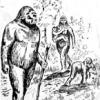Genes are made up of base pairs. But when looking at a whole gene, say between a Chimp and a Bonobo there will be inserted base pairs and deleted base pairs within a shared gen that make each respective gene do something a little different. For instance, one Human gene of that comes from each Human parents will be selected. And even though the genes are essentially the same, each gene will contain different information that gets selected and passed onto a child. That's how one brother can have red hair and another brown. Stuff like that will not change one species into another. It's when a shared gene does something different that makes the difference.
We share the gene that creates an appendage with many animals, but we get toes where others get hoofs. By the same token, Chimps and Bonobos are genetically 98.9% close to us. But unlike we Humans who are .1% different from each other, Chimps and Bonobos are more like .4% from each other. It doesn't sound like a whole lot, but it really is. Just ask your self how much is .4% (.004) of around 3,000,000,000 (billion) nuclear base pair? Answer: .4% of 3 billion translates into 12 million base pairs differences. In mitochondrial DNA ..4& of its 16,569 is about 66 base pairs. Now go look at the table I posted on the Chimp/Bonobo thread and see what a base pair difference of 66 would mean. Look at the genetic sequence difference between Chimps and Bonobos.
So, my friend, I'm not trying to have it both ways really. I see it this way, in genetics there is truth. Every living thing has a specific blueprint. And so would a Sasquatch. That's why I study genetics. To see if it holds up as a tool for proof of discovery. It does.


